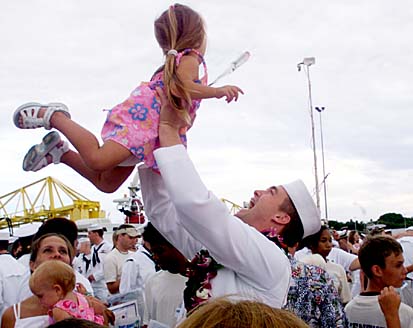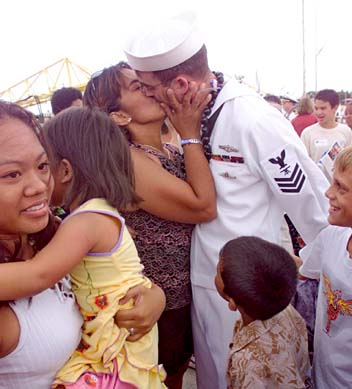
DENNIS ODA / DODA@STARBULLETIN.COM
Soldiers from the 1st Battalion, 21st Infantry, have learned they will be deployed to Afghanistan in February. Patrick Scott organized his gear yesterday at Schofield Barracks.
Heading out for and
home from the frontAs Schofield soldiers assess
a new mission, a Pearl Harbor
sub returns from Iraq duty
Army Pvt. 1st Class Anthony Jackson said that for nearly a month "there were a lot of hints" at Schofield Barracks that his 25th Infantry Division unit was going to Afghanistan.
But "when we were told on Monday that we were going for sure, it was like a kick in the head," said Jackson, 20, who has been in the Army for 1 1/2 years.
Jackson, a member of the 25th Infantry Division's 2nd Brigade, said he now realizes that "all the training we are doing has to be taken seriously."
While up to 7,000 25th Infantry soldiers at Schofield were getting used to the idea of upcoming duty in a hostile territory, 138 sailors from the nuclear submarine USS Key West returned to Pearl Harbor yesterday after a six-month deployment that included launching Tomahawk missiles into Iraq.
Yesterday's brief snapshot of military life here reflects the increased tempo the country's armed forces now face.
The Pentagon says that 368,900 soldiers are on duty in 120 countries, including the United States: 232,759 active-duty troops from a force of 485,000, 74,551 National Guard members from a pool of 352,000, and 61,590 reservists out of a force of 206,000. Of the Army's 33 active-duty combat brigades, 24 had been deployed overseas this year.
FL MORRIS / FMORRIS@STARBULLETIN.COM
The USS Key West returned home to Pearl Harbor yesterday after taking part in the conflicts in Iraq and Afghanistan. Michael Donkersloot, left, raised his daughter Charlotte in jubilation.
For the first time in the 25th Division's 62-year history, it will be sending 7,000 soldiers to Southwest Asia. Until now all of the Tropic Lightning's major combat operations have been to the South Pacific, Japan, Vietnam and the Korean peninsula.
Several members of the 2nd Brigade's 1st Battalion, 299th Infantry, talked yesterday about what they expect when they are sent to Afghanistan in February. They will spend six months there and will be replaced by the 25th Division's 3rd Brigade.
They said they will rely on their training to prepare them for the bitter winter and possible contact with terrorists.
Sgt. Jeffrey Adkins, a team leader with Charlie Company, said being ready to fight is what he has been working up to for nearly six years.
"I feel my training will take effect automatically," said Adkins, 23.
Pvt. 1st Class Mike Starnes, 20, added that "nobody knows what will happen when live bullets start flying around you. But I will be there to protect my family, my country. You just have to rely on what you have been taught and hopes that it kicks in."
FL MORRIS / FMORRIS@STARBULLETIN.COM
James Nixon was kissed by his wife, Salina, as their children looked on.
Capt. Kealii Morris, who attended Kamehameha Schools while his father, Col. Rod Morris, was stationed here, said his company is "ready to go. Everybody's motivated."
Jackson said he has been told by his father, who served in Desert Storm and Somalia, to rely on his training. "Stay calm," was the advice Jackson's father passed on to him. "It's panic that kills you."
At Pearl Harbor, Navy Cmdr. Chuck Merkel, skipper of the USS Key West, said a well-trained crew enabled him to make history by being the first submarine commanding officer since World War II to lead back-to-back combat operations.
He said that nearly 60 of the 138 sailors were on the Key West when it launched Tomahawk missiles into Afghanistan in the retaliatory raids following the Sept. 11, 2001, terrorist attacks.
When the Iraq war began in March, the Key West was one of four Pearl Harbor submarines to strike targets in Iraq.
Merkel cannot say the exact number of missiles the Key West fired. However, past reports have quoted Navy officials saying that about 300 of the more than 800 Tomahawk missiles fired during Operation Iraqi Freedom came from submarines.
Petty Officer Cody Hollingsworth served as a nuclear mechanic on the Key West on the two historic voyages. Asked to cite differences between the two voyages, Hollingsworth said "there wasn't really much ... just a lot of excitement."


